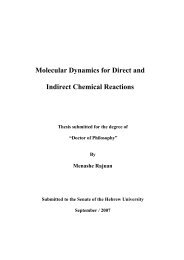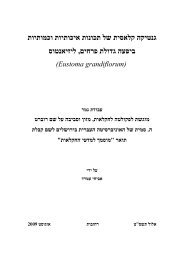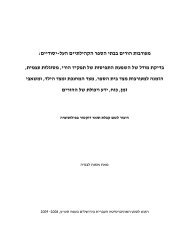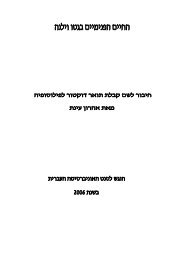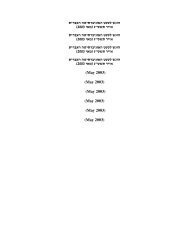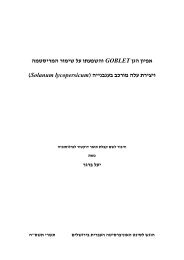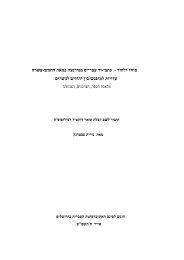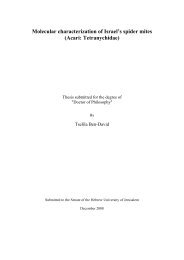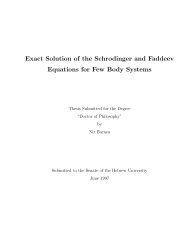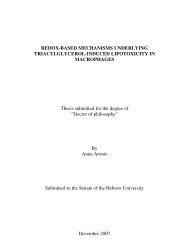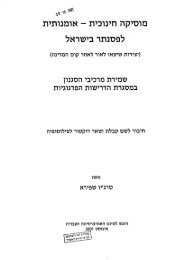Revealing the Mechanism of HSP104 Transcription Initiation in the ...
Revealing the Mechanism of HSP104 Transcription Initiation in the ...
Revealing the Mechanism of HSP104 Transcription Initiation in the ...
Create successful ePaper yourself
Turn your PDF publications into a flip-book with our unique Google optimized e-Paper software.
Next, we attempted to directly measure <strong>the</strong> occupancy <strong>of</strong> Msn2 and Msn4 on<br />
<strong>the</strong> promoter. Similarly to Hsf1, we constructed Ha-tagged prote<strong>in</strong>s and <strong>in</strong>serted <strong>the</strong>m<br />
<strong>in</strong> <strong>the</strong> yeast genome at <strong>the</strong> URA3 locus. We were unfortunately unsuccessful <strong>in</strong><br />
detect<strong>in</strong>g ei<strong>the</strong>r Msn2 or Msn4 on <strong>the</strong> <strong>HSP104</strong> promoter under normal or heat shock<br />
conditions. Fur<strong>the</strong>rmore, we could not measure via ChIP assays Msn2/4 b<strong>in</strong>d<strong>in</strong>g <strong>in</strong><br />
ras2∆ cells <strong>in</strong> which <strong>the</strong>se two transcriptional activators are believed to constitutively<br />
b<strong>in</strong>d STREs (data not shown). We tried different variations <strong>of</strong> tagg<strong>in</strong>g Msn2 (ei<strong>the</strong>r<br />
at <strong>the</strong> N-term<strong>in</strong>us or C-term<strong>in</strong>us) and we also tried to over-express Msn2 under <strong>the</strong><br />
Alcohol Dehydrogenase 1 (ADH1) promoter known to be a strong constitutive<br />
promoter. We also tried grow<strong>in</strong>g cells <strong>in</strong> m<strong>in</strong>imal media (YNB) as opposed to rich<br />
media (YPD). In all cases, DNA b<strong>in</strong>d<strong>in</strong>g <strong>of</strong> <strong>the</strong> prote<strong>in</strong>s was not detected although<br />
<strong>the</strong> Msn2/4 prote<strong>in</strong>s were confirmed to be expressed and active. It seems that <strong>the</strong><br />
<strong>in</strong>ability to measure Msn2/4 b<strong>in</strong>d<strong>in</strong>g via ChIP is not specific to our laboratory. There<br />
is no report <strong>in</strong> <strong>the</strong> literature on successful ChIP on Msn2 or Msn4. Some reports (part<br />
<strong>of</strong> all genome b<strong>in</strong>d<strong>in</strong>g assay) do report on Msn2/4 b<strong>in</strong>d<strong>in</strong>g to some promoter, (but<br />
with very low aff<strong>in</strong>ity) (135). We still do not know whe<strong>the</strong>r <strong>the</strong> reason is technical or<br />
conceptual (reflect<strong>in</strong>g no direct association <strong>of</strong> Msn2/4 with DNA).<br />
SAGA, SRB/MED and SWI/SNF are important for <strong>HSP104</strong> promoter activity<br />
The experiments described above analyzed <strong>the</strong> <strong>HSP104</strong> promoter and<br />
provided an <strong>in</strong>sight <strong>in</strong>to <strong>the</strong> events occurr<strong>in</strong>g on nucleosomes located on <strong>the</strong> <strong>HSP104</strong><br />
promoter. The experiments fur<strong>the</strong>r showed that <strong>the</strong>se events are controlled, at least <strong>in</strong><br />
part, by <strong>the</strong> activators Msn2/4. Hav<strong>in</strong>g identified <strong>the</strong> major activators <strong>of</strong> <strong>the</strong> promoter<br />
and some <strong>of</strong> <strong>the</strong>ir effects on chromat<strong>in</strong> organization we sought to identify <strong>the</strong> basal<br />
transcription factors required for heat shock <strong>in</strong>duced <strong>HSP104</strong> transcription. To<br />
uncover <strong>the</strong>se factors, we tested <strong>HSP104</strong> promoter activity <strong>in</strong> various mutants from<br />
<strong>the</strong> Saccharomyces Genome Deletion Project. Mutants <strong>in</strong>cluded those lack<strong>in</strong>g a gene<br />
encod<strong>in</strong>g a basal transcription factor. Into each <strong>of</strong> <strong>the</strong>se mutants we <strong>in</strong>troduced<br />
(separately) three reporter genes: i) -334LacZ, ii) STRE-LacZ and iii) HSE-LacZ.<br />
Activity <strong>of</strong> <strong>the</strong> -334LacZ manifests <strong>the</strong> activity <strong>of</strong> <strong>the</strong> full length promoter. Activity<br />
<strong>of</strong> STRE-LacZ [-260LacZ <strong>in</strong> (47)] manifests <strong>the</strong> function <strong>of</strong> <strong>the</strong> promoter activity<br />
dependent on Msn2/4. The HSE-LacZ reporter conta<strong>in</strong>s <strong>the</strong> HSE cluster <strong>of</strong> <strong>HSP104</strong><br />
<strong>in</strong> four repeats fused to <strong>the</strong> CYC1 m<strong>in</strong>imal promoter. This reporter reflects <strong>the</strong><br />
activity <strong>of</strong> Hsf1. 69 stra<strong>in</strong>s (Table 3) were tested with <strong>the</strong> three different plasmids.<br />
36



